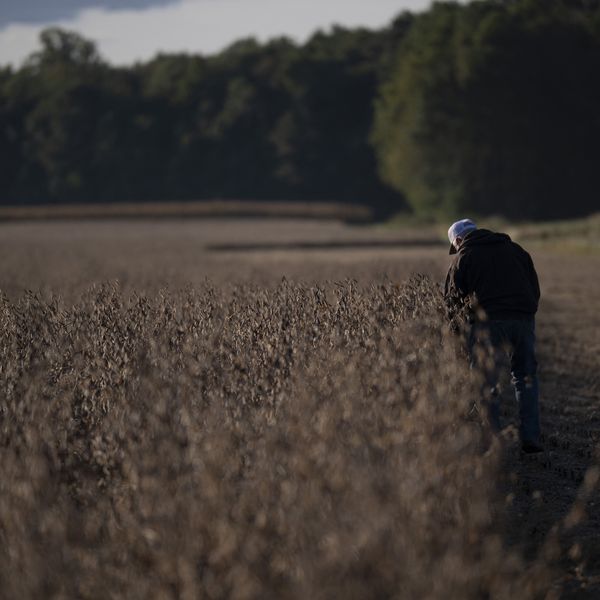Farmers Cut Back as Beleaguered California Hit by Water Loss
State accepts voluntary water cutbacks by farmers as vandals loose 50m gallons from dam
A day before California accepted voluntary water cutbacks by farmers, vandals targeting an inflatable dam in Fremont sent 50 million gallons of water meant for the city's residents flowing into the San Francisco Bay.
"This is a very significant loss of water under any circumstances, and more so in the drought conditions we are experiencing," Robert Shaver, the Alameda County water district general manager, told the Oakland Tribune on Thursday. "It is an utterly senseless, destructive, and wasteful thing to do."
According to the ACWD, the lost water could have supplied 500 homes for a year.
The loss is the latest setback for the state, which is in the midst of a historic four-year drought that has led to Governor Jerry Brown imposing mandatory water cutbacks on urban consumers for the first time ever.
Brown's order has gotten a lukewarm reception in the state--not for the loss of green lawns, but for its exemption of the agricultural industry, which consumes 80 percent of California's water.
After weeks of public outcry over the lopsided order, the state water board announced Friday that it had accepted a deal from farmers to cut back their water usage by 25 percent.
Scores of farmers made the deal to stave off stricter mandatory cuts, which the water board said it would impose if the two sides could not reach a deal. The plan applies only to riparian rights holders--landowners who have direct access to a river or stream.
The LA Times reports:
In a move reflecting the growing severity of California's drought, state water regulators have accepted a historic proposal by Delta region farmers to voluntarily cut water usage by 25%, or, alternatively, to allow a quarter of their fields to lay idle.
...Under the plan, growers must submit online applications to the water board by June 1, and outline how they will reduce water usage relative to their 2013 levels. If approved, the voluntary restrictions will remain in place through September, ending Oct. 1.
Since the plan is voluntary, it remains to be seen how many farmers will participate--which, in turn, makes it hard to guess how much water will be saved by the effort. Still, conservationists in the state say it is better than nothing.
"It is a sign that creative solutions to the drought are possible and that everyone must make sacrifices, whether it's cutting back on watering our yards or laying some crops fallow," Brian Stranko, director of the Nature Conservancy's water program, told the LA Times.
An Urgent Message From Our Co-Founder
Dear Common Dreams reader, The U.S. is on a fast track to authoritarianism like nothing I've ever seen. Meanwhile, corporate news outlets are utterly capitulating to Trump, twisting their coverage to avoid drawing his ire while lining up to stuff cash in his pockets. That's why I believe that Common Dreams is doing the best and most consequential reporting that we've ever done. Our small but mighty team is a progressive reporting powerhouse, covering the news every day that the corporate media never will. Our mission has always been simple: To inform. To inspire. And to ignite change for the common good. Now here's the key piece that I want all our readers to understand: None of this would be possible without your financial support. That's not just some fundraising cliche. It's the absolute and literal truth. We don't accept corporate advertising and never will. We don't have a paywall because we don't think people should be blocked from critical news based on their ability to pay. Everything we do is funded by the donations of readers like you. Will you donate now to help power the nonprofit, independent reporting of Common Dreams? Thank you for being a vital member of our community. Together, we can keep independent journalism alive when it’s needed most. - Craig Brown, Co-founder |
A day before California accepted voluntary water cutbacks by farmers, vandals targeting an inflatable dam in Fremont sent 50 million gallons of water meant for the city's residents flowing into the San Francisco Bay.
"This is a very significant loss of water under any circumstances, and more so in the drought conditions we are experiencing," Robert Shaver, the Alameda County water district general manager, told the Oakland Tribune on Thursday. "It is an utterly senseless, destructive, and wasteful thing to do."
According to the ACWD, the lost water could have supplied 500 homes for a year.
The loss is the latest setback for the state, which is in the midst of a historic four-year drought that has led to Governor Jerry Brown imposing mandatory water cutbacks on urban consumers for the first time ever.
Brown's order has gotten a lukewarm reception in the state--not for the loss of green lawns, but for its exemption of the agricultural industry, which consumes 80 percent of California's water.
After weeks of public outcry over the lopsided order, the state water board announced Friday that it had accepted a deal from farmers to cut back their water usage by 25 percent.
Scores of farmers made the deal to stave off stricter mandatory cuts, which the water board said it would impose if the two sides could not reach a deal. The plan applies only to riparian rights holders--landowners who have direct access to a river or stream.
The LA Times reports:
In a move reflecting the growing severity of California's drought, state water regulators have accepted a historic proposal by Delta region farmers to voluntarily cut water usage by 25%, or, alternatively, to allow a quarter of their fields to lay idle.
...Under the plan, growers must submit online applications to the water board by June 1, and outline how they will reduce water usage relative to their 2013 levels. If approved, the voluntary restrictions will remain in place through September, ending Oct. 1.
Since the plan is voluntary, it remains to be seen how many farmers will participate--which, in turn, makes it hard to guess how much water will be saved by the effort. Still, conservationists in the state say it is better than nothing.
"It is a sign that creative solutions to the drought are possible and that everyone must make sacrifices, whether it's cutting back on watering our yards or laying some crops fallow," Brian Stranko, director of the Nature Conservancy's water program, told the LA Times.
A day before California accepted voluntary water cutbacks by farmers, vandals targeting an inflatable dam in Fremont sent 50 million gallons of water meant for the city's residents flowing into the San Francisco Bay.
"This is a very significant loss of water under any circumstances, and more so in the drought conditions we are experiencing," Robert Shaver, the Alameda County water district general manager, told the Oakland Tribune on Thursday. "It is an utterly senseless, destructive, and wasteful thing to do."
According to the ACWD, the lost water could have supplied 500 homes for a year.
The loss is the latest setback for the state, which is in the midst of a historic four-year drought that has led to Governor Jerry Brown imposing mandatory water cutbacks on urban consumers for the first time ever.
Brown's order has gotten a lukewarm reception in the state--not for the loss of green lawns, but for its exemption of the agricultural industry, which consumes 80 percent of California's water.
After weeks of public outcry over the lopsided order, the state water board announced Friday that it had accepted a deal from farmers to cut back their water usage by 25 percent.
Scores of farmers made the deal to stave off stricter mandatory cuts, which the water board said it would impose if the two sides could not reach a deal. The plan applies only to riparian rights holders--landowners who have direct access to a river or stream.
The LA Times reports:
In a move reflecting the growing severity of California's drought, state water regulators have accepted a historic proposal by Delta region farmers to voluntarily cut water usage by 25%, or, alternatively, to allow a quarter of their fields to lay idle.
...Under the plan, growers must submit online applications to the water board by June 1, and outline how they will reduce water usage relative to their 2013 levels. If approved, the voluntary restrictions will remain in place through September, ending Oct. 1.
Since the plan is voluntary, it remains to be seen how many farmers will participate--which, in turn, makes it hard to guess how much water will be saved by the effort. Still, conservationists in the state say it is better than nothing.
"It is a sign that creative solutions to the drought are possible and that everyone must make sacrifices, whether it's cutting back on watering our yards or laying some crops fallow," Brian Stranko, director of the Nature Conservancy's water program, told the LA Times.

